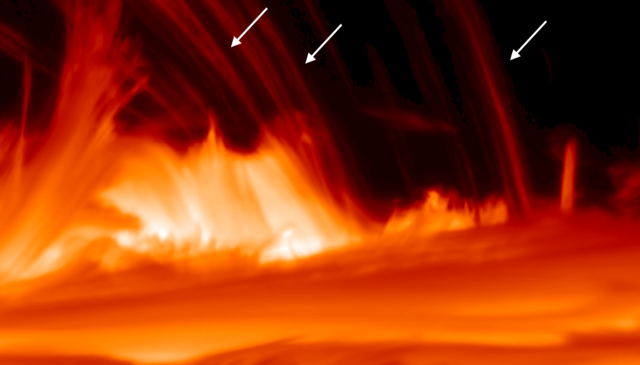Coronal rain is one of the most striking features of the solar atmosphere. A post written by Dr. Clara Froment, from the Institute of Theoretical Astrophysics, University of Oslo (Norway).

Coronal rain observed near the footpoints of large coronal loops in H-alpha with the SST on La Palma in 2017.
And this is not unusual. Actually, all what it takes to observe coronal rain is to target any active region located at the solar limb, prepare to observe in chromospheric or transition region lines with a suitable instrument, either from the ground or from space, and then be patient enough to witness the “catastrophic cooling” that happens in some magnetic loops.
The figure shows coronal rain observed near the footpoints of large coronal loops, here in H-alpha with the SST on La Palma in 2017. This image was produced by stacking 20 frames (about 2 minutes of data) to unravel the loop path the rain blobs is tracing. The coronal rain strands are marked with arrows.
Coronal rain is one of the most striking features of the solar atmosphere. The corona is the upper layer of the atmosphere of the Sun. It is a very dynamic layer, where the structures, like coronal loops for example, are shaped by the magnetic field. Compared to the conditions in the lower atmosphere, the density of the plasma in the corona is usually very low (108 particles per cm3) and the temperature very high (106 K).
Strangely enough, the production of the cool material that constitutes coronal rain and also prominences is a consequence of the way the plasma is heated through the solar atmosphere.
In the most common cases coronal rain is produced when the heating is very stable and mostly located at the feet of the coronal loops. Such heating will supply the coronal structure with plasma evaporating from the chromosphere (a very dense layer). This hot and dense plasma, that has now reached coronal heights, will start to cool down. Because there are more losses than heating in that situation, the plasma will cool down more and more and eventually form condensations (about 100 times cooler and 100 times denser that the surrounding coronal plasma) that will fall down the loop legs due to the solar gravity. If the magnetic structure forms a dip, the condensations cannot fall and will stay up at coronal heights forming a prominence.
The details of the production of cool material in the corona are giving us important clues on the coronal heating mechanisms. Especially on the spatial location and timescale of the heating.
Observing coronal rain from the ground allows us to have very high resolution observations and makes possible to reveal the fine structures in coronal loops. Indeed, our current measurements indicates that coronal rain blobs have width of about 100 km. These rain blobs are believed to mostly follow the magnetic field lines, such that they uncover the topology of the fundamental strands that compose the coronal loops.
With the even higher resolution that EST will provide, we will be able to see how small the rain blobs actually can get and to better understand their formation. Our diagnostics of their thermodynamics will be also improved by the higher spectral and temporal resolution that will be available.
